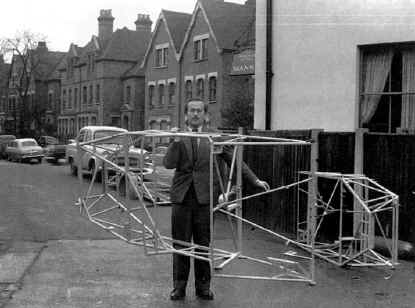|
|
|
|
Design and Production
|
|
|
Lotus founder Colin Chapman formed a team of hard-working volunteers to help him create a break- through model for 1956. While production Lotus Marks 8, 9 and 10 were based on the Lotus Mark 6, the Eleven was drawn from scratch. Its closest ancestor was the works Mk 9 LeMans racer, registered XPE 6, a test-bed for what was to come. The Eleven used a steel tubular space-frame with stressed aluminum panels. The elegant chassis weighed under 70 pounds. It was powered by the new Coventry-Climax aluminum four-cylinder engine, an overhead cam design with an impressive power-to- weight-ratio. Girling disc brakes were used, and parts adapted from all sorts of period English cars made up the rest of the machine. Covering the vehicle was a stunning aerodynamic body designed by Frank Costin: hand-made of aluminum and hinged at both ends for complete access. The Eleven was as advanced as anything on wheels. |
 |
At left, Chapman
and some frames outside the 'works' on Tottenham Lane, in London's north
end. Lotus
were considered 'scientifically designed' racing
cars, with each component engineered for maximum efficiency from minimum weight
. The Chapman philosophy strived for each part to serve
two or more functions, with no more mass than absolutely necessary to do
the job. Contemporary race drivers saw the Lotus as THE
car for winning races, even at the risk of not finishing at all.
|
|
Production History
|
|
|
From January 1956 when the
first Elevens were hurriedly assembled for the press introduction in
AutoSport or to be shipped to the USA for their race debut, cars were
built as rapidly as the tiny Lotus shop could manage. The frames
were made by Progress Chassis Co., with the bodies and panels
from Williams & Pritchard, both
practically next-door. Cars were either assembled in-house or
sold as kits.
Elevens could be ordered in the full-spec LeMans version which used a deDion rear suspension arrangement, or the less costly Club version which substituted an Austin live rear axle and drum brakes all around. Lastly, a Sports version was available which was essentially a Club with a Ford 10 engine. Initially all Elevens used swing-axle front suspension modified from parts from the English Ford model 93E. In the Spring of 1957, after about 150 cars had been produced, a new version of the Eleven was introduced as the Series-2. The main difference, and usually only on the LeMans version, was the Lotus 12-type double A-arm front suspension that gave the car more forgiving and consistent handling. The S-2 had improvements to the chassis, a stronger drivetrain and could accept larger engines. By the Summer of 1958 a total of about 270 Elevens had been completed when production focus shifted to newer models, including Formula 1 cars. |
|
The Eleven was the first Lotus built in such numbers, and it firmly established the company as a serious maker of competition cars. It held such a place in Chapman's heart that future Lotus were given names that recalled it, like Elite and Elan.
Contemporary articles Autosport: THE NEW LOTUS-CLIMAX "ELEVEN" Sports Cars Illustrated : Don't Ever Call Him Henry Sheep in Wolf's Clothing: Cross Country in an Eleven Motor Sport road test of the Lotus Sports Road & Track: test of the LeMans, March 1957 Road & Track: test of the Sports, September 1957 MOTOR: The LOTUS XI LeMans "85" Motor Trend: driving around in a Lotus Club track test- Lotus XI Series 1 & 2
|
|
|
HOME
to www.lotuseleven.org
|
|